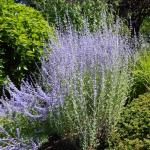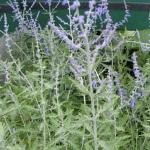Herbal Oil: Russian Sage and Rice Bran SOLD OUT
SOLD OUT. I'LL SEE IF I HAVE ANOTHER BATCH TO DECANT.
Salvia yangii Russian or Lavender Sage formerly called Perovskia atriplicifolia in Ricinus communis. Harvested in the #Bloorcourt neighbourhood of Toronto and made by me. 1:10 Standardization Here is sage essential oil.
The species has a long history of use in traditional medicine in its native range of the steppes and hills of southwestern and central Asia (not Russia!). The foliage has a fragrance described as a blend of sage and lavender.
Packaged in a 100mL blue glass bottle.
Pre-orders accepted for when it's ready in the fall of 2025.
SUGGESTED USES: I suggest that the herbal oil be used in massage, in healing and pain-relieving balms, and as part of an insect-repelling formula for skin or plants.
PLEASE NOTE THAT IF YOU ARE LOOKING FOR AN INSECT REPELLENT, here's what you are looking for: Perfume: Outdoor, Tick -ed Off Repellant and Bite Antiseptic A ready-to-use, evidence-based blend of dissolved essential and skin-friendly jojoba oil that I created both as a repellent and as a treatment once you have removed a tick.
TICKS WILL PHYSICALLY DISTANCE FROM YOU!
CHEMISTRY: Various monoterpenes and monoterpenoids are the dominant components, such as carene, eucalyptol, limonene, γ-terpinene, and (+)-β-thujone. Camphor can also be a prevalent component. Other monoterpenes, camphene, α-pinene, and β-pinene are also present, as are sesquiterpenes such as γ-cadinene, δ-cadinene, trans-caryophyllene, and α-humulene. Several terpenoid alcohols—borneol, cedrol, and menthol have been extracted, as have caffeic acid and ferulic acid. More complex compounds have been isolated: perovskatone, the glycosides atriplisides A and B; and atricins A and B, a pair of triterpenes that are similar to oleanane. Four diterpene glucosides have been isolated by extraction.
FULL PLANT Salicyna, CC BY-SA 4.0, via Wikimedia Commons
CLOSEUP Photo by David J. Stang, CC BY-SA 4.0, via Wikimedia Commons
#Handmade #MadeinToronto #Hancrafted #Natural #Cosmetics #DIY #Healthy #Bodycare #Vegan #Aromatherapy #ShopEthical #ShopSmall #ShopLocal #SmallBusiness #Toronto #Bloorcourt #Bloordale #BloorWest #supportlocal #shopsmallbusiness #AnarresNaturalHealth #AnarresHealth #Sustainable #ZeroWaste #EcoFriendly #Green #Responsible #FairTrade #Healthy #Greenwitch




